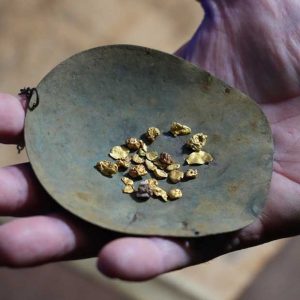
The mother lode of winter storms has sent water blasting through rock crevices and rivers in the Sierra Nevada, leading to more glittering discoveries by prospectors.
PLACERVILLE,Cali.-Albert Fausel spends his days at the family hardware store sorting through boxes of bolts and pacing the old, creaking floorboards to greet his loyal clientele. But on a recent sunny afternoon, he threw on his wet suit and diver’s mask and inserted himself face down in the shallow creek near his home.
An amateur gold seeker, Mr. Fausel used his gloved fingers to sweep aside the sand and gravel at the bottom of the creek and then, still under water, let out a cry that was audible through the tube of his snorkel: “Woooo-hoo-hoooo!” He emerged with what gold seekers call a picker-not quite a nugget, but big enough to pinch in your fingers-and he delicately handed the glinting object to his fellow prospector, a friend with a long white beard who goes by Uncle Fuzzy. In just 20 minutes of rooting around the creek bed, Mr. Fausel had found about $100 worth of gold.
There’s a fever in California’s gold country these days, the kind that comes with the realization that nature is unlocking another stash of precious metal. California’s prodigious winter rainfall blasted torrents of water through mountain streams and rivers. And as the warmer weather melts the massive banks of snow-one research station in the Sierra recorded 60 feet for the season-the rushing waters are detaching and carrying gold deposits along the way. The immense wildfires of recent years also loosened the soil, helping to push downstream what some here are calling flood gold.
It has been nearly 175 years since the Gold Rush that drew countless wagons and ships filled with prospectors, but the foothills of the Sierra Nevada mountains are still home to a quirky group of gold seekers, heavy on beards and flannel, who pore over old maps for the site of a now-vanished saloon or walk the back country searching for nuggets and other artifacts.
Placerville is a 15-minute drive from the valley where James Marshall, a carpenter from New Jersey, was building a sawmill in January 1848 along the American River when something shiny in the water caught his eye. “Some kind of mettle,” wrote one of his workers in his diary in the quirky spellings of the time, “that looks like goald.”
The big chunks of the easy-to-find gold that had been lolling around in rivers for millenniums were gone after the first years of the Gold Rush, and Marshall himself died penniless. But miners resorted to spraying powerful jets of water onto hillsides and sorting through what flowed down, leaving giant piles of mining residue still visible today.
Placerville is a 15-minute drive from the valley where James Marshall, a carpenter from New Jersey, was building a sawmill in January 1848 along the American River when something shiny in the water caught his eye. “Some kind of mettle,” wrote one of his workers in his diary in the quirky spellings of the time, “that looks like goald.”
That kind of extraction is now heavily restricted in California, yet gold seekers say the recent battering of successive winter storms has produced a similar effect. It is as if Mother Nature had aimed a pressure washer onto the hills and delivered some of the precious minerals still embedded in the rock and dirt.
“Anytime you can stand next to a river, and you hear the boulders tumbling, you know the gold is moving, too,” said Jim Eakin, the owner of a local firewood business who tells the story of finding a nugget so big four years ago that he bought a brand-new Ford F-150 pickup truck with cash. Like many of his gold-seeking friends, Mr. Eakin, who often wears a nugget around his neck, is cagey when asked about exactly where he unearthed the chunk of gold that got him the truck.
Mr. Eakin, whose gravelly voice betrays the pack and a half of cigarettes he smokes daily, does not own a computer and has never sent a text message. He revels in the hunt for treasure. He finds coins of all sizes and Gold-Rush-era belt buckles, and he travels to a big gem show in Tucson, Ariz., to sell his nuggets. It is a hobby that requires a lot of patience: For every big find, there are many days where-to use a gold-mining expression-things don’t pan out.
With the price of gold hovering near highs of $2,000 an ounce, Mr. Eakin counts himself among a group of gold seekers who can “read the ground” and profit from the fortuitous winter weather.
“It’s going to be a magnificent year,” said Tony Watley, president of the Gold Country Treasure Seekers club, which meets at the American Legion hall the third Monday of every month. “Everywhere we are seeing new erosion.” The Treasure Seekers get-togethers feature a show-and-tell portion where members display their finds on fold-up tables. Those who attended the March meeting were agog when someone laid out two pounds of gold nuggets he had found with a metal detector, the method preferred by most of the club’s members.
“There was $50,000 of gold up at that table,” said Mark Dayton, a regular at the club. “We’ve had more gold in the last two meetings than I’ve seen in the last two years.”
Mr. Dayton, a former police officer and firefighter, now makes a living as a treasure hunter. In just a few outings in April, he found $750 worth of gold pieces. Gold seekers like him predict the best is yet to come, when the river levels recede and the rocks and sandbars become accessible.
There is no shortage of reminders that Placerville, the seat of El Dorado County about an hour east of Sacramento, is gold country. In and around the town there is Gold Country Chiropractic, the Gold Trail School, the Gold Hill Winery, the 49er liquor store, and the Gold Harvest Market on Mother Lode Drive.
Placerville, once a stop along the Pony Express trail and known as Hangtown because of the vigilante justice once meted out there, trades on its Gold Rush history. Mr. Fausel’s store, Placerville Hardware, lays claim to being the oldest continuously operating hardware store west of the Mississippi River. It sells gold panning equipment like sluice boxes, plastic pans with ridges to trap gold, metal detectors and small glass vials to preserve any pickers and flakes that amateur prospectors might find.
For travelers headed to Lake Tahoe, Placerville is not much more than an inconvenient stoplight or two along the main highway. And young people these days seeking fortunes would sooner head to the Silicon Valley than pick up a gold pan. Today’s gold seekers range from part-time hobbyists keen to spend an afternoon by the river to the die-hard, well-equipped treasure hunters who make a living from it. Gold shops in the area buy the gold and either melt it down or in some cases convert it into jewelry.
On a recent afternoon, Mr. Dayton was accompanied along the Cosumnes River by a friend, Barron Brandon, a former mining executive and an amateur gold seeker in retirement. The two men hacked away at rocks and sand in a crevice between boulders. One of Mr. Dayton’s metal detectors squawked loudly and, after further digging, they unearthed what had excited the machine: a worthless piece of rebar. Mr. Brandon showed no sign of disappointment. He stood near the rushing river, the rolling hills covered in white oaks, the pristine creeks flowing gently beside grassy knolls dotted with wildflowers. “The true gold is just being out here,” he said.
James Holifield, a high school student who lives in a Sacramento suburb, came to the banks of the American River on his last day of spring break, inspired by some videos on YouTube. “There’s something about gold,” he said, looking the part in a flannel shirt and rubber boots that covered his shins.
After two hours he had found four flakes of gold. His mother, sitting in a portable chair a few yards back from the river, said she was grateful that her son had chosen a “low-investment” hobby. And watching him pan for gold, she said, beats seeing him glued to his phone.
